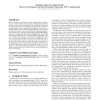Free Online Productivity Tools
i2Speak
i2Symbol
i2OCR
iTex2Img
iWeb2Print
iWeb2Shot
i2Type
iPdf2Split
iPdf2Merge
i2Bopomofo
i2Arabic
i2Style
i2Image
i2PDF
iLatex2Rtf
Sci2ools
EENERGY
2010
2010
Energy-aware traffic engineering
Energy consumption of the Internet is already substantial and it is likely to increase as operators deploy faster equipment to handle popular bandwidthintensive services, such as streaming and video-on-demand. Existing work on energy saving considers local adaptation relying primarily on hardwarebased techniques, such as sleeping and rate adaptation. We argue that a complete solution requires a network-wide approach that works in conjunction with local measures. However, traditional traffic engineering objectives do not include energy. This paper presents Energy-Aware Traffic engineering (EATe), a technique that takes energy consumption into account while achieving the same traffic rates as the energy-oblivious approaches. EATe uses a scalable, online technique to spread the load among multiple paths so as to increase energy savings. Our extensive ns-2 simulations over realistic topologies show that EATe succeeds in moving 21% of the links to the sleep state, while keeping the same se...
| Added | 02 Sep 2010 |
| Updated | 02 Sep 2010 |
| Type | Conference |
| Year | 2010 |
| Where | EENERGY |
| Authors | Nedeljko Vasic, Dejan Kostic |
Comments (0)

